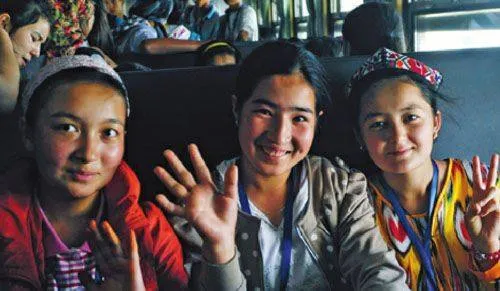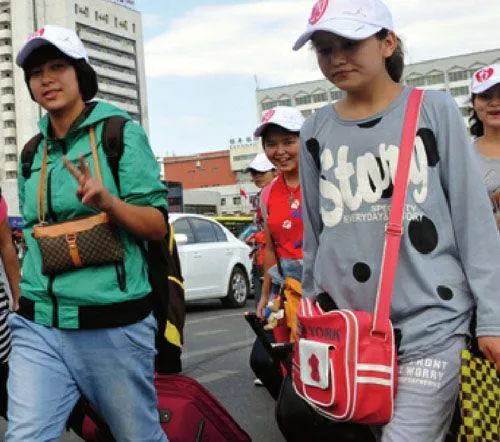Far Ou
In the vast and sparsely populated Xinjiang Uygur Autonomous Region in China’s northwest, more than half of the residents are members of minority ethnic groups with native languages other than Mandarin Chinese. Education is complicated by the region’s linguistic, geographic and socioeconomic conditions.
“In my hometown, educational resources are scarce and dropout rates are very high,” said Merhaba, a 13-year-old Uygur girl from Kashgar Prefecture. “Almost all my cousins dropped out after middle school or even primary school. My brother and I are the only ones to go out of Kashgar for education.”
Merhaba is a student at No.66 Middle School in Urumqi, the capital city of Xinjiang. Her exam scores earned her admission to the elite junior high school in 2011. “Here, we have better teachers and better learning facilities,” she said.

for a better future
Launched in September 2000, a merit-based program has enabled students from remote areas in Xinjiang to attend prestigious high schools in developed cities in China’s east. The program offers students from Xinjiang free tuition, room and board.
In 2000, a total of 1,000 students were admitted to 12 key schools, and the number grew year by year. By 2012, as many as 8,330 students had been admitted to 85 elite schools in 44 eastern cities. Altogether 51,300 students have benefited from the program since its inception. Ninety percent are from minority ethnic groups.
In 2003, the Xinjiang Regional Government designated No.66 Middle School in Urumqi to groom promising students and help them make the even more difficult transition into schools in major cities in east China.
Now the school has more than 900 students, of which 90 percent are students from rural and pastoral areas. Fourteen-year-old Rhustan from Kashgar has been studying at the school for nearly two years. “The teaching quality here is a lot better and it makes it easier for us to gain knowledge,” said Rhustan, who speaks fluent English.
It’s not easy for a child to leave home and go to a faraway city to study at the tender age of 12, but Rhustan is mature for his age, and pragmatic and filial in equal measure. “Although they miss me a lot, my parents think it is the right decision for a better future and they are proud of me,” he said.
For Li Ji, though, studying in Urumqi is not getting easier, but much harder. The 14-yearold Han boy, also from Kashgar, is now in the eighth grade at No.66 Middle School.
“It was easy for me to score in the top three in my previous school in Kashgar, but here all the top students from different places in Xinjiang gather, and I have to work very hard to keep up.”
To enroll at No.66 Middle School, according to Li, candidates had to score more than 275 out of 300 on a selection exam. After three years’ study, the students must take yet another selection exam to enroll in key high schools in eastern cities. In the later exams, they have to score more than 690 out of 750 to qualify.
“It is a big challenge,” said Li. “I cannot make mistakes.”
Li felt very homesick when he first arrived in Urumqi. “Everything is so different here—the weather, the food and we need to deal with everything by ourselves,” said Li, who got through those days with the help of teachers and classmates. “The interesting in-class and extracurricular activities helped a lot.”

Li’s dream is to become a policeman and he said he hopes to go to Shanghai for further studies. “After I graduate from university, I would come back to Xinjiang and make contributions to my hometown.”
Guliweina, a 13-year-old girl from Turpan, is a classmate of Li. She set up this school as the goal when she was in the sixth grade in the primary school in Turpan. Her elder sister is a graduate here and went to Beijing for senior high school. Now her sister is a student at the Communication University of China, located in the nation’s capital. “I admire my sister a lot and Beijing is my ideal place too,” said Guliweina.
A bigger picture
“In Urumqi alone, there are already four schools offering preparatory classes for students to attend high school in east China, with 10,000 students graduating each year,” said Meng Lang, Principal of No.66 Middle School.
Meng revealed that in order to bring more children from rural and pastoral households into better schools, Xinjiang has opened junior middle school classes in eight cities including Urumqi, Shihezi, Karamay, Kuytun, Changji, Hami, Korla and Aksu.
Instruction is mainly in Mandarin and English. “Teachers here are dedicated, not only to teaching, but also to the breakdown of ethnic barriers,” said Meng. “Multilingual education is necessary. If they can write and speak in their own ethnic languages and Mandarin and English, that will help them better integrate with the outside world.”
Wuziguli, an eighth grader at No.66 Middle School, started bargaining in Mandarin to get a higher price for the grapes in her father’s field in 2012.
“My family earned more than other families in my village because I can speak Mandarin fluently,” the little girl said with a smile.
“Children are the future,” said Meng. “If we want to reduce poverty in Xinjiang, we need to develop education. Education empowers people’s minds and that’s more important than anything else.”
“We are on our way to improving educatiosEEr/GN1aM3Y5Xc0OvhFOrjekmRnXedvX2ngcZVk1dg=n for ethnic minorities, which is crucial for regional economic development,” said Tursun Ibrayim, head of the Education Department of Xinjiang.
Tursun said that the policy of sending Xinjiang’s high school students to study in eastern cities is welcomed by parents and children in the region. “Improving the quality of education among ethnic minorities is important to Xinjiang’s social and economic development,”said Tursun.
According to Tursun, raising the educational level of the Xinjiang population is no easy task for this underdeveloped northwest region, which accounts for nearly a sixth of the nation’s territory and has a population of over 21.3 million.
He noted that since 2003, more than 60 billion yuan ($9.77 billion) has been invested in education in Xinjiang. In 2013, the autonomous region will allocate another 2.6 billion yuan ($424 million) in compulsory education.
“Education for all is the wish of every parent, child, educator and government official in Xinjiang,” he said.

